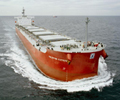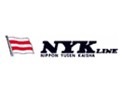Dry Bulk Market: Goodbulk Ltd. Says Limited Fleet Growth and Rebound in Cargo Demand to Boost 2021 Dry Bulk Rates

GoodBulk Ltd., a leading owner and operator of dry bulk vessels, announces its financial results for the fourth quarter of 2020.
4th Quarter Highlights
• Generated $7.6 million of net profit resulting in earnings per share (EPS) of $0.25. EBITDA for the period was $20.1 million.
• Declared a $0.20 per share capital repatriation, resulting in cumulative distribution of $3.66 per share, or 33.27% of the price of the Company’s March 2017 Norwegian OTC initial offering.
• Earned an average gross Time Charter Equivalent rate (TCE) of $15,971 per day on our Capesize vessels and $15,374 per day on our Panamax vessel.
• Averaged direct vessel operating expenses for the period of $5,676 per vessel per day.
• Ended the period with a cash balance of $37.6 million.
• Employed the Capesize vessels M/V Aquasurfer, M/V Nautical Dream and M/V Aquamarie for period charters of about a year in direct continuation with their previous charterers.
Recent Developments
• On 2 March 2021 the Board of Directors authorized the payment to Shareholders of $10.2 million ($0.34 per share) as capital repatriation.
• As of 8 March 2021, for the first quarter of 2021 the Company has fixed approximately 85% of its Capesize days at about $14,700 per vessel per day (equivalent to reported gross TCE).
GoodBulk is a leading owner of dry bulk vessels executing a strategy combining low financial leverage with active portfolio management to optimize operational leverage to the dry bulk freight market. This strategy has resulted in GoodBulk announcing a profitable quarter, with $7.6 million net profit ($0.25 per share). The Company’s strict financial discipline resulted in industry leading general and administrative expenses of $322 per vessel per day, which compares with $425 per vessel per day for the same period in 2019; pure cash G&A were at $208 per vessel per day.
Market Commentary
For the quarter ending 31 December 2020, the Baltic Capesize Index averaged $16,944 per day, 23.6% below $22,185 per day for the same period 2019 and 18.4% below $20,761 per day for the quarter ending 30 September 2020. Baltic Capesize Index rates averaged $13,070 per day, in 2020, 27.5% below $18,025 per day in 2019. In the fourth quarter November and December saw the weakest rates which coincided with a drop in iron ore export volumes as well as weak coal imports into China. In November 2020, iron ore exports from the two largest exporting nations, Brazil and Australia, dropped to 98 million tonnes, 6 million tonnes lower month-on-month and China’s restrictions on imported coal volumes led them to decline to just 12 million tonnes in November 2020, the lowest figure in almost a year. However, the strong La Nina phenomenon that ensued which brought extremely low temperatures in the Far East meant that China had to reconsider its import policy leading to a surge in imports in December 2020 reaching a record 39 million tonnes over two thirds of which came from Indonesia (compared to Indonesia’s more typical share of China’s coal imports of around 40%) and none from Australia potentially an indication of the political rift between the two countries. This contributed to the strength seen in the Panamax and Supramax segments and exacerbated the situation for the Capesize vessels at the end of last year as the latter tend to not be as suited for Indonesia’s exports.
All the dry bulk vessel segments have seen an incredibly strong start to 2021. It was the strongest January for the Capesize segment since 2010 with the Baltic’s time charter average coming in at $21,678 per day compared to an average of $10,700 per day for the Januaries between 2011 and 2020. The Panamax and Supramax sectors too have reached numbers unseen in over a decade and even exceeding $20,000 per day some days in February and March 2021. The ‘dislocation’ between Panamax and Capesize rates from early February (with Panamax rates having moved up and Capesize rates having fallen) is common early on in the year and can last for up to two months as the more volatile Capesizes are dragged down mainly by weather related issues in Brazil and the more stable Panamaxes are supported by coal and grain demand. The Panamaxes and Supramaxes have experienced an exceptionally strong grain trade with China absorbing huge volumes as well as extremely cold temperatures in the Northern hemisphere which have pulled up coal volumes.
Currently, the outlook for 2021 is for an improvement on 2020 rates for all dry cargo segments thanks to the limited fleet growth and an expected rebound in cargoes. A globally balanced recovery in commodity demand (not solely Chinese demand) rests largely on the severity of the pandemic and whether the world can manage to curb fatality rates. So far as at early-March 2021 the pandemic is still in full swing with some countries reporting more fatalities than at the onset however increased knowledge of how the virus spreads and who is more vulnerable has allowed economies to cautiously restart. The start of vaccination programmes around the world as of December 2020 is bringing hope to the global community and we expect some immunity to the virus to start forming although insufficient supplies, wariness and mutating strains can be a hindrance.
Full ReportSource: GoodBulk Ltd.

 Hellenic Shipping News Worldwide Hellenic Shipping News Worldwide, Online Daily Newspaper on Hellenic and International Shipping
Hellenic Shipping News Worldwide Hellenic Shipping News Worldwide, Online Daily Newspaper on Hellenic and International Shipping






















 PG-Software
PG-Software